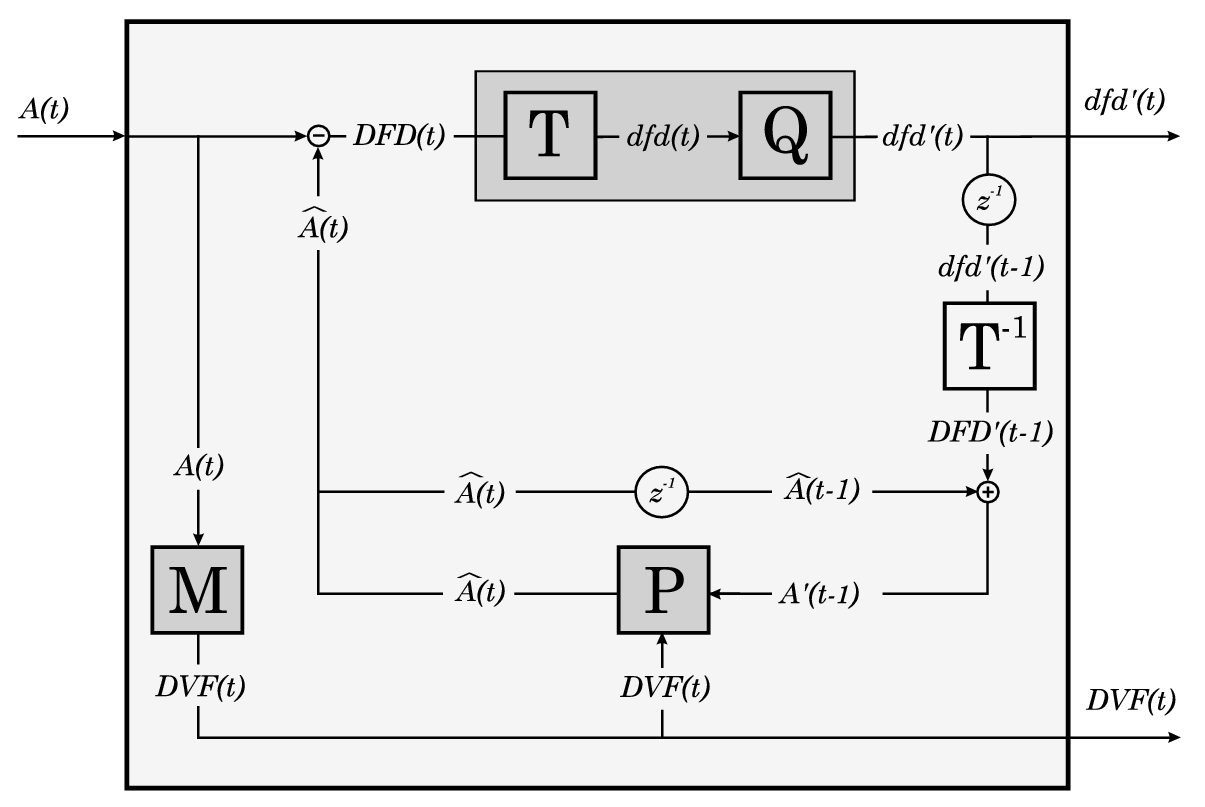|
MOTION
ESTIMATION
Our approach to motion estimation
in video
sequences was motivated by the general scheme of the current video
coders
with motion compensation (such as MPEG-X or H.26X [Musmann85, LeGall91,
Tekalp95]).
In
motion
compensation video coders the input sequence, A(t), is analized by a
motion
estimation system, M, that computes some description of the
motion
in the scene: typically the optical flow, DVF(t). In the motion
compensation
module, P, this motion information can be used to predict the
current
frame, A(t), from previous frames, A(t-1). As the prediction,
Â(t),
is not perfect, additional information is needed to reconstruct the
sequence:
the prediction error DFD(t). This scheme is useful for video
compression
because the entropy of these two sources (motion, DVF, and errors, DFD)
is significantly smaller than the entropy of the original sequence A(t).
The coding gain can be even
bigger if the
error sequence is analyzed, and quantized, in an appropriate transform
domain, as done in image
compression
procedures, using the transform T and the quantizer Q.
Coder
 |
Decoder
 |
Conventional optical flow
techniques (based
in local maximization of the correlation by block matching) provide a
motion
description that may be redundant for a human viewer. Computational
effort
may be wasted describing 'perceptually
irrelevant
motions'. This inefficient behavior may also give rise
to
false alarms and noisy flows. To solve this problem, hierarchical
optical
flow techniques have been proposed (as for instance in MPEG-4 and in
H.263).
They start from a low resolution motion estimate and new motion
information
is locally added only in certain regions. However, new motion
information
should be added only if it is 'perceptually
relevant'. Our contribution in
motion estimation is a definition of 'perceptually relevant motion
information'
[Malo98, Malo01a,
Malo01b].
This definition is based on the entropy of the image
representation in the human cortex (Watson JOSA 87, Daugman IEEE
T.Biom.Eng.
89): an increment in motion information is perceptually relevant if it
contributes to decrease the entropy of the cortex representation of the
prediction error. Numerical experiments (optical flow computation and
flow-based
segmentation) show that applying this definition to a particular
hierarchical
motion estimation algorithm, more robust and
meaningful
flows are obtained [Malo00b,
Malo01a, Malo01b].
Here is an illustration of why
the use
of perceptual information, Hp, (volume of the signal quantized using
band-pass
bit allocation) can give rise to a motion estimation strategy which is
scale dependent, i.e. it encourages increasing the resolution at coarse
levels, but it becomes conservative for higher resolutions:

Here is an example of the motion
flows and motion based
segmentations
obtained using different motion estimation algorithms. Note that all
the
segmentations use the same segmentation algorithm [Wang&Adelson94]
and only differ on the motion flow.

Taxi Sequence

| MPEG-1 flow |
H.263/MPEG-4
flow [Dufaux95] |
Our method |

Ideal segmentation

| Segment.
from MPEG-1 flow |
Segment.
from [Dufaux95]
flow |
Segment.
from our flow |
PUBLICATIONS
|
J. Malo and M. Simón
Modelos Corticales de Percepción del
Movimiento.
Conferencia Invitada en la Jornada de
Presentación de Aletheia Nº5,
Rector Peset, Universitat de València, Feb. 2008
|
|
J. Malo
La percepción del movimiento: parte
de lo que pasa por tu cabeza en unos milisegundos.
Aletheia, CADE, Universitat de
València, Nº 5, pp 11-17, Dec 2007
|
|
J.
Malo, J. Gutierrez, I. Epifanio
What motion information is
perceptually
relevant?.
Journal of Vision,
1(3), 309a,
http://journalofvision.org/1/3/309, DOI 10.1167/1.3.309
(2001)
|
|
J.Malo,
J.Gutierrez, I.Epifanio and F.Ferri
Perceptually weighted
optical flow
for motion-based segmentation in MPEG-4 paradigm.
Electronics Letters ,
Vol.36, 20,
pp.1693-94, (2000)
|
|
J.Malo,
F.Ferri, J.Albert, J.M.Artigas
Splitting criterion for
hierarchical
motion estimation based on perceptual coding.
Electronics Letters ,
Vol. 34,
6, pp.541-543. (1998)
|
|
F.Ferri,
J.Malo, J.Albert, J.Soret
Variable-size BMA for
motion estimation
using a perceptual-based splitting criterion.
Proc. IEEE Int. Conf. Pat.
Recog. 98.
Vol. I, pp. 286-288. (1998)
|
|
|



